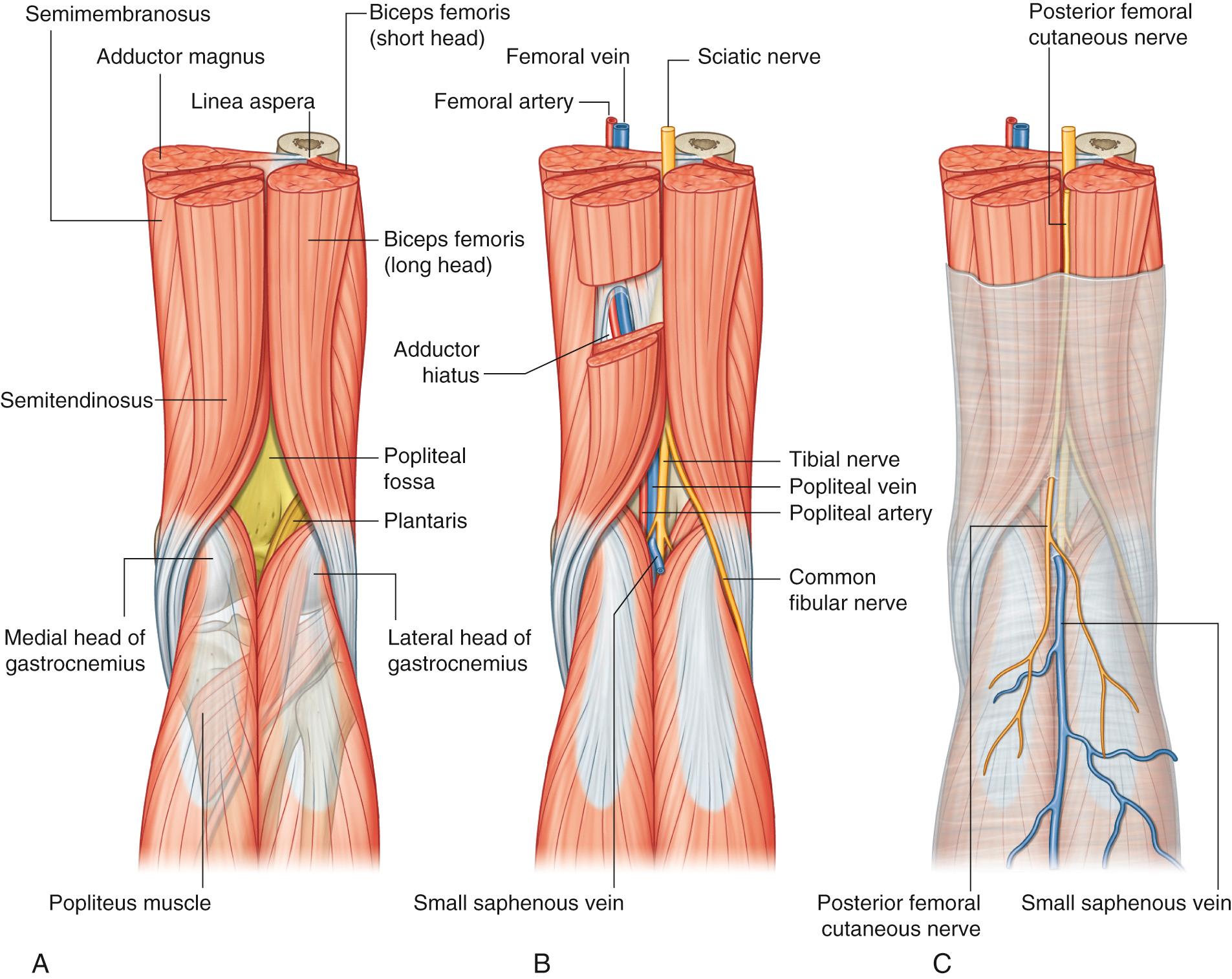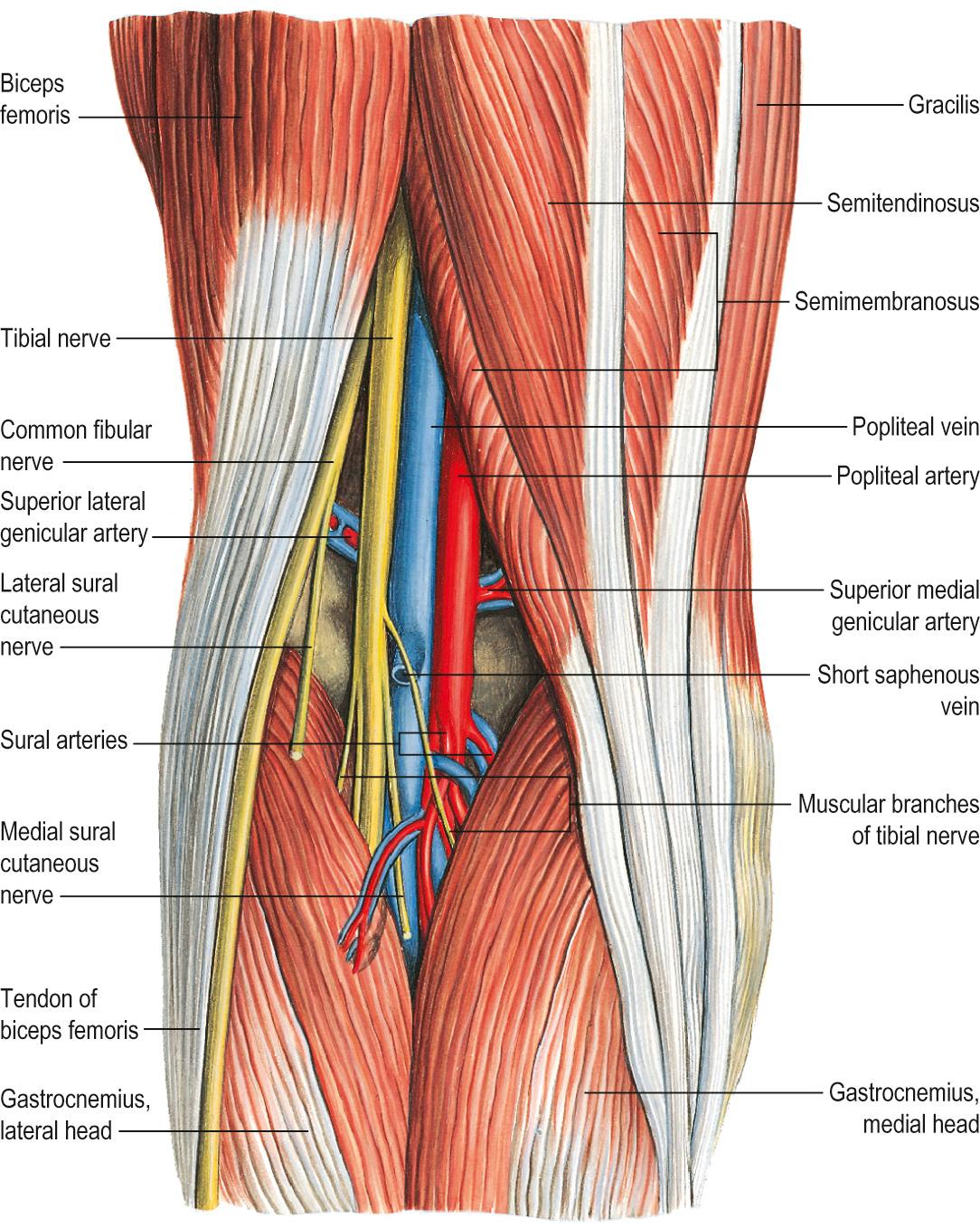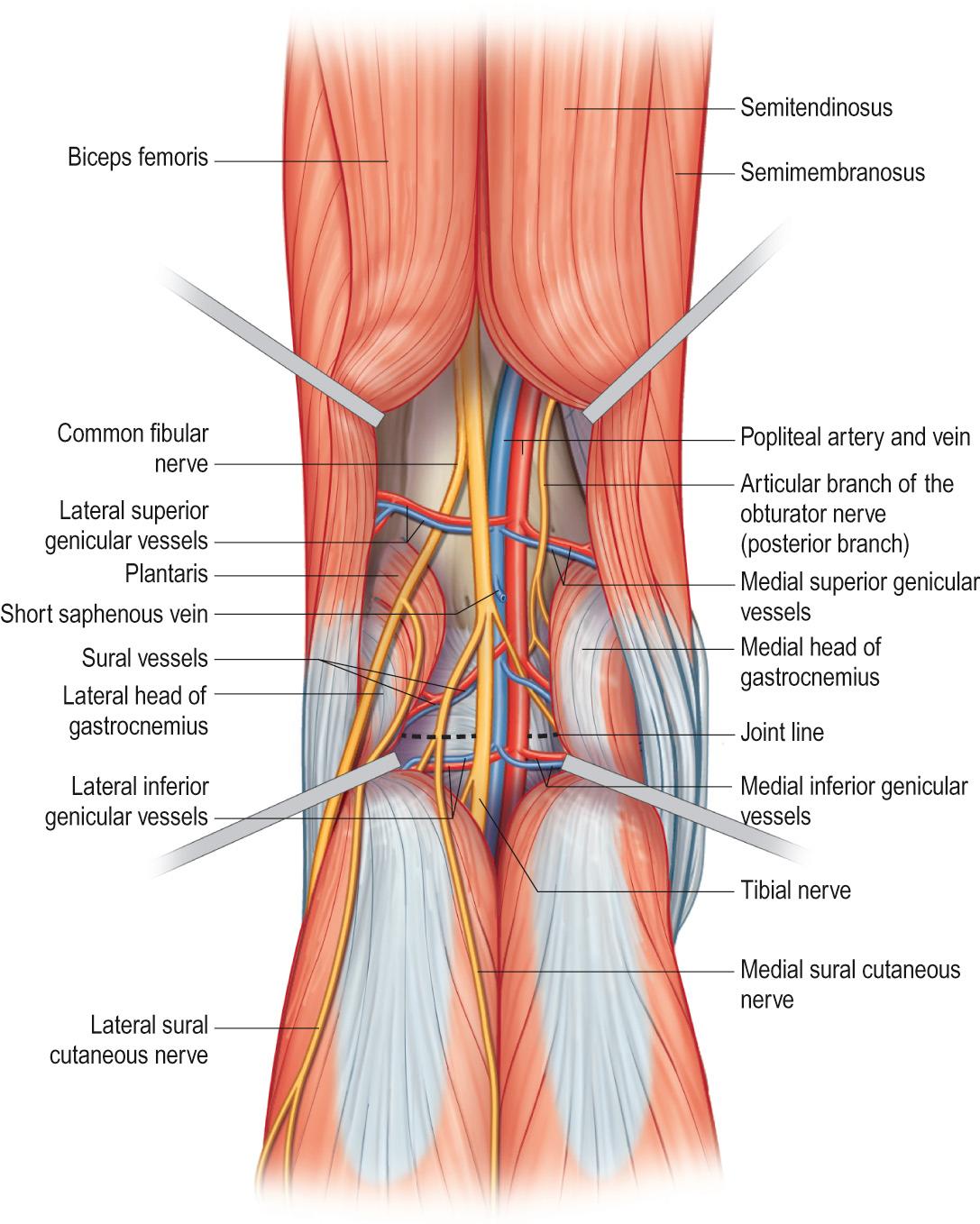Physical Address
304 North Cardinal St.
Dorchester Center, MA 02124
Repair of neurovascular structures
Excision of lesions: for example, Baker cyst, tumours
Fixation of avulsed posterior cruciate ligament (PCL) attachment
Fixation of posterior knee structures: for example, fixation of posterior fractures of the femoral condyle, posterior capsular repair
Gastrocnemius recession for contracture
Hamstring lengthening
The uppermost part of the popliteal fossa is about a hand's breadth proximal to the knee joint line; in most individuals, the sciatic nerve divides into the tibial and common fibular nerves in this region. The insertion tendon of biceps femoris forms a thick cord that can be traced distally to the head of the fibula. The common fibular nerve runs along the medial border of the tendon of biceps femoris. The cord-like tendon of semitendinosus lies medial to the broad tendon of semimembranosus. Inferiorly, the two heads of gastrocnemius are palpable posterior to the femoral condyles. Flexing the knee may facilitate palpation of the tendons of the hamstrings and the popliteal artery. The popliteal artery bifurcates at the level of the head of the fibula.
The superior half of the popliteal fossa forms a soft elevation between the tendons of the hamstrings. In the fully extended knee, fat protrudes between the tendons of the medial and lateral hamstrings. Flexing the knee reveals a depression, the popliteal fossa, and renders the tendons of the hamstrings more prominent. The popliteal artery runs along an imaginary line drawn from the junction of the middle and distal thirds of the thigh, 2.5 cm medial to the posterior midline of the lower extremity, to a midpoint between the femoral condyles; the vessel continues inferolaterally to divide at the inferior border of popliteus ( Fig. 82.1 ).

The popliteal fossa is a fat-filled space that facilitates the passage of neurovascular structures between the thigh and the leg. In cadavers, the diamond-shaped space is bound superomedially by the tendons of semitendinosus and semimembranosus, superolaterally by the tendon of biceps femoris, and inferiorly by the two heads of gastrocnemius. In the living, the two heads of gastrocnemius meet in the midline and the popliteal fossa per se extends distally deeper to the muscle.
The skin, superficial and popliteal fasciae form the roof of the popliteal fossa; the two heads of gastrocnemius lie distally. The skin overlying the fossa receives its blood supply from branches of the popliteal artery and perforating vessels, and is innervated by branches of the posterior femoral cutaneous nerve derived from S1–3 ventral rami. The skin tension lines (Langer's lines) over the fossa run parallel to the flexion skin crease, which means that a transverse skin incision is less likely to produce flexion contractures.
The superficial fascia contains the short saphenous vein, which may be accompanied by the medial sural cutaneous nerve and branches of the posterior femoral cutaneous nerve. The vein pierces the fascia to drain into the popliteal vein. The medial sural cutaneous nerve, a branch of the tibial nerve, commonly pierces the fascia at the popliteal fossa but it may also run deep to the popliteal fascia up to the midcalf. Branches from the posterior femoral cutaneous nerve traverse this layer in their ascent from the leg.
The popliteal fascia is continuous with the fascia lata and the crural fascia. The popliteal fascia is strong and therefore capable of limiting expansion of the contents of the fossa: for example, the tibial nerve may be compressed by an aneurysm of the popliteal artery ( Fig. 82.2 ![]() ).
).

The popliteal fossa contains the popliteal artery and vein, the terminal part of the short saphenous vein, the tibial and common fibular nerves, the posterior femoral and sural cutaneous nerves, variable articular twigs from the terminal part of the posterior branch of the obturator nerve, popliteal lymph nodes and multiple bursae ( Fig. 82.3 ; see Fig. 82.2 ).

The popliteal artery, the deepest of the neurovascular structures, is the continuation of the femoral artery distal to the adductor hiatus. It runs along an imaginary line drawn from the junction of the middle and distal thirds of the thigh, 2.5 cm medial to the posterior midline, to a point halfway between the femoral condyles, and continues inferolaterally to divide into the tibial and common fibular nerves at the inferior border of popliteus. At the joint line, the artery is closely related to the joint capsule with a mean distance of 2.8 mm, and to the posterior horn of the lateral meniscus. The artery supplies intra-articular structures, the hamstrings, gastrocnemius, soleus, plantaris and the skin around the knee. The popliteal and femoral arteries communicate via the genicular anastomosis. The popliteal artery gives rise to five genicular branches that supply the knee joint and regional structures: the superior medial and lateral genicular, the inferior medial and lateral genicular, and the middle genicular arteries. The superior genicular vessels encircle the distal femur. The middle genicular artery originates near the midpoint of the posterior knee and pierces the posterior joint capsule to supply the cruciate ligaments; in so doing, it tethers the popliteal artery to the joint capsule. The inferior genicular arteries originate under gastrocnemius. The genicular arteries anastomose with the recurrent tibial, circumflex fibular branches of the posterior tibial and descending genicular arteries.
The popliteal vein traverses the popliteal fossa contained in a fibrous sheath together with the popliteal artery; the vein lies superficial to the artery and deep to the tibial nerve. The short saphenous vein pierces the popliteal fascia between the two heads of gastrocnemius to drain into the popliteal vein at, or just superior to, the joint line.
The tibial nerve descends along the middle of the fossa, crossing the popliteal artery from lateral to medial. Proximally, the nerve gives off articular branches, the medial sural cutaneous nerve and motor branches to gastrocnemius, soleus, popliteus and plantaris. The common fibular nerve descends obliquely along the medial border of biceps femoris. It gives off the lateral sural cutaneous nerve and articular branches, exits the popliteal fossa superficial to the lateral head of gastrocnemius, and pierces fibularis longus to wind around the head and neck of the fibula. In most cases, superficial branches of the posterior femoral cutaneous nerve pierce the popliteal fascia to enter the popliteal fossa. Branches join to form the nerve proper, which runs deep to the popliteal fascia and superficial to biceps femoris to reach the posterior thigh ( Fig. 82.4 ).

The popliteal fossa contains 5–7 scattered lymph nodes embedded in fat. The superficial node lies in the subcutaneous tissue near the termination of the short saphenous vein and receives superficial lymphatic drainage from the leg. The deep nodes are closely related to the popliteal vessels and receive drainage from the knee joint and the deep lymphatics of the leg.
The floor of the popliteal fossa extends from the medial and lateral supracondylar lines of the femur proximally to the soleal line of the tibia distally. In addition to the posterior surfaces of the distal femur and proximal tibia, the floor is formed by popliteus, investing fascia and the joint capsule. Popliteus is attached to the lateral condyle of the femur and meniscus proximally, and to the posteromedial tibia just proximal to the soleal line distally. The reflected part of the tendon of semimembranosus forms the oblique popliteal ligament, reinforcing the posterior joint capsule. A fibrous extension of the tendon of semimembranosus forms the investing fascia of popliteus.
The direct posterior approach to the knee is used for vascular repair ; fixation of posterior femoral condyle and tibial plateau fractures ; repair of avulsed PCL tibial insertion; gastrocnemius recession; hamstring lengthening; excision of tumour or cysts ; posterior synovectomy; and, recently, posterior inlay PCL repair. A lazy S-shaped incision is begun superolaterally over biceps femoris at the required level; the incision is curved medially towards the midpoint of the skin crease and extended distally over the medial head of gastrocnemius. Avoiding acute angles, a full-thickness fasciocutaneous flap is created. The incision crosses the short saphenous vein, the sural cutaneous nerves and the superficial branches of the posterior femoral cutaneous nerve in the superficial fascia. In its ascent, the short saphenous vein leads the surgeon to the popliteal fossa.
The popliteal fascia is incised from a point just medial to the entry point of the short saphenous vein up to the most superior aspect of the popliteal fossa by tracing the tibial nerve proximally. At this point, the sciatic nerve often divides into the tibial and common fibular nerves. The common fibular nerve is traced down the medial border of biceps femoris. The popliteal artery and vein run deep to the tibial nerve.
To gain access to the posteromedial joint space, deep dissection proceeds just anterior to the medial head of gastrocnemius, which may be detached from its femoral origin and subsequently repaired. To gain access to the posterolateral joint space, deep dissection proceeds between the lateral head of gastrocnemius and biceps femoris. The common fibular nerve is at risk here. The deep dissection is equivalent to the medial and lateral approaches to the knee. Very rarely, the posterior joint space is entered between the two heads of gastrocnemius. The exposure can be extended distally to expose the terminal branches of the popliteal artery.
Posterior knee arthroscopy is used in synovectomy; PCL reconstruction; all-inside repair of the posterior horn of the medial meniscus; and excision of tissue or tumours posterior to the PCL. The posteromedial portal is introduced through a triangle bound by the medial collateral ligament, the medial head of gastrocnemius and the tendon of semimembranosus at the level of the joint line. The posterolateral portal is introduced just anterior to the tendon of biceps femoris.
Become a Clinical Tree membership for Full access and enjoy Unlimited articles
If you are a member. Log in here